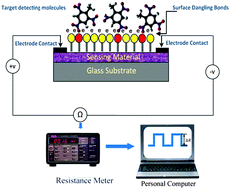Reducing cross-sensitivity of TiO2-(B) nanowires to humidity using ultraviolet illumination for trace explosive detection
Abstract
Environmental humidity is an important factor that can influence the sensing performance of a metal

* Corresponding authors
a Applied Physics Laboratory & Electrical Engineering, University of Washington, Seattle, Washington 98105, USA
b
Department of Physics, University of South Florida, Tampa, Florida 33620, USA
E-mail:
antaochen@usf.edu
Fax: +1 813 974 5813
Tel: +1 813 974 4326
c
Materials Sciences and Engineering Department, University of Washington, Seattle, Washington 98105, USA
E-mail:
ajen@u.washington.edu
Environmental humidity is an important factor that can influence the sensing performance of a metal

 Please wait while we load your content...
Something went wrong. Try again?
Please wait while we load your content...
Something went wrong. Try again?
D. Wang, A. Chen and A. K.-Y. Jen, Phys. Chem. Chem. Phys., 2013, 15, 5017 DOI: 10.1039/C3CP43454K
To request permission to reproduce material from this article, please go to the Copyright Clearance Center request page.
If you are an author contributing to an RSC publication, you do not need to request permission provided correct acknowledgement is given.
If you are the author of this article, you do not need to request permission to reproduce figures and diagrams provided correct acknowledgement is given. If you want to reproduce the whole article in a third-party publication (excluding your thesis/dissertation for which permission is not required) please go to the Copyright Clearance Center request page.
Read more about how to correctly acknowledge RSC content.
 Fetching data from CrossRef.
Fetching data from CrossRef.
This may take some time to load.
Loading related content
